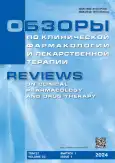Problem questions of prevention and precising control of diseases associated with hypoxia
- Authors: Lyubimov A.V.1
-
Affiliations:
- Kirov Military Medical Academy
- Issue: Vol 22, No 1 (2024)
- Pages: 33-39
- Section: Reviews
- Submitted: 06.12.2023
- Accepted: 28.02.2024
- Published: 27.04.2024
- URL: https://journals.eco-vector.com/RCF/article/view/624289
- DOI: https://doi.org/10.17816/RCF624289
- ID: 624289
Cite item
Abstract
Cardiovascular diseases are the one of the main causes of death in the 21st century. Their rating is not expected to be decreased in the near future despite all the successes in the wide distribution and using of high-tech methods of treatment. This article is devoted to the problem of introducing fundamental recent discoveries into practical medicine as part of the development of preventive, personalized and precision medicine. The author considers not used mechanisms of endogenous adaptation, prevention and preclinical diagnosis of hypoxia-associated diseases in the clinic and concludes that introducing of a new marker of adaptation to visceral hypoxemia is perspective approach in therapy of the cardiovascular diseases.
Keywords
Full Text
About the authors
Andrey V. Lyubimov
Kirov Military Medical Academy
Author for correspondence.
Email: lyubimov_av@mail.ru
ORCID iD: 0000-0001-9829-4681
SPIN-code: 5307-4186
MD, Cand. Sci. (Medicine)
Russian Federation, Saint PetersburgReferences
- Arnaudov GD. Medical terminology in five languages. Sofia: Medicine and Physical Education; 1979. 943 p. (In Russ.)
- Zarubina IV, Shabanov PD. From the S.P. Botkin’s idea of «preexposure» to preconditioning phenomenon. Perspectives for use of phenomena of ischemic and pharmacological preconditioning. Reviews on Clinical Pharmacology and Drug Therapy. 2016;14(1): 4–28. EDN: VVEOFJ doi: 10.17816/RCF1414-28
- Murry CE, Jennings RB, Reimer KA. Preconditioning with ischemia: a delay of lethal cell injury in ischemic myocardium. Circulation. 1986;74(5):1124–1236. doi: 10.1161/01.cir.74.5.1124
- Ivanov AO, Beliayev Vf, Smurov AV, et al. The effect of periodic normobaric hypoxia on human circulatory red blood cells. Marine medicine. 2015;1(4):35–39. (In Russ.) EDN: WIMXIL doi: 10.22328/2413-5747-2015-1-4-35-39
- Bezkishkii EN, Ivanov AO, Petrov VA, et al. Human working capacity in periodic stay in hypoxic air environments, reducing the fire hazard of sealed objects. Human ecology. 2018;(9):4–11. EDN: XZDHIL doi: 10.33396/1728-0869-2018-9-4-11
- Argunova YuA, Barbarash OL. Optimizing patient preparation prior to cardiac surgery. Russian journal of cardiology and cardiovascular surgery. 2023;16(2):171–177. (In Russ.) EDN: YXAYPY doi: 10.17116/kardio202316021171
- Kudryashov VS, Fateev IV, Kim AE, et al. Ischemic preconditioning: prospects of application for the correction of physical performance in military, extreme and sports medicine. Siberian scientific medical journal. 2023;43(2):74–82. (In Russ.) EDN: MSCVEW doi: 10.18699/SSMJ20230207
- Galagudza MM. Pre- and postconditioning as ways to protect myocardium from ischemic and reperfusion injury: an experimental study [dissertation abstract]. Saint Petersburg, 2007. 39 p. (In Russ.) Available from: https://viewer.rsl.ru/ru/rsl01003068303?page=1&rotate=0&theme=white.
- Yamshchikova AV, Fleishman AN, Martynov ID, et al. Clinical effects of ischemic preconditioning in polyneuropathy of various origins. Hygiene and sanitation. 2023;102(4):362–366. (In Russ.) EDN: JHZOHQ doi: 10.47470/0016-9900-2023-102-4-362-366
- Shljahto EV, Nifontov EM, Galagudza MM. Limitation of ischemic and reperfusion myocardial damage by means of pre- and postconditioning: molecular mechanisms and targets for pharmacotherapy. Creative cardiology. 2007;(1–2):75–101. (In Russ.) EDN: KAOPSR
- Semenza GL. O2-regulated gene expression: transcriptional control of cardiorespiratory physiology by HIF-1. J Appl Physiol. 2004;96(3):1173–1177. doi: 10.1152/japplphysiol.00770.2003
- Semenza GL, Wang GL. A nuclear factor induced by hypoxia via de novo protein synthesis binds to the human erythropoietin gene enhancer at a site required for transcriptional activation. Mol Cell Biol. 1992;12(12):5447–5454. doi: 10.1128/mcb.12.12.5447-5454.1992
- Ausserer WA, Bourrat-Floeck B, Green CJ, et al. Regulation of c-jun expression during hypoxic and low-glucose stress. Mol Cell Biol. 1994;14(8):5032–5042. doi: 10.1128/mcb.14.8.5032-5042.1994
- Lyubimov AV, Khokhlov PP. Participation of HIF-1 in the mechanisms of neuroadaptation to acute stressful exposure. Reviews on clinical pharmacology and drug therapy. 2021;19(2):183–188. EDN: IWCMMN doi: 10.17816/RCF192183–188
- Lando D, Gorman JJ, Whitelaw ML, Peet DJ. Oxygen-dependentregulation of hypoxia-inducible factors by prolyl and asparaginyl hydroxylation. European Journal of Biochemistry. 2003;270(5):781–790. doi: 10.1046/j.1432-1033.2003.03445.x
- Murphy BJ, Andrews GK, Bittel D, et al. Activation of metallothionein gene expression by hypoxia involves metal response elements and metal transcription factor-1. Cancer Research. 1999;59(6):1315–1322.
- Risau W. Mechanisms of angio+genesis. Nature. 1997; 386(6626):671–674. doi: 10.1038/386671a0
- Semenza GL. The Genomics and Genetics of Oxygen Homeostasis. Annu Rev Genomics Hum Genet. 2020;21:183–204. doi: 10.1146/annurev-genom-111119-073356
- Semenza GL. Oxygen-regulated transcription factors and their role in pulmonary disease. Respir Res. 2000;1(3):159–162. doi: 10.1186/rr27
- Wenger RH. Cellular adaptation to hypoxia: O2-sensing protein hydroxylases, hypoxia-inducible transcription factors, and O2-regulated gene expression. The FASEB Journal. 2002;16(10):1151–1162. doi: 10.1096/fj.01–0944rev
- Gu YZ, Hogenesch JB, Bradfield CA. The PAS superfamily: sensors of environmental and developmental signals. Ann Rev Pharm Toxicol. 2000;40:519–561. doi: 10.1146/annurev.pharmtox.40.1.519
- Zhang W, Yu M, Zhang Q, et al. DFO treatment protects against depression-like behaviors and cognitive impairment in CUMS mice. Brain Res Bull. 2022;187:75–84. doi: 10.1016/j.brainresbull.2022.06.016
- Tang X, Wang P, Zhang R, et al. KLF2 regulates neutrophil activation and thrombosis in cardiac hypertrophy and heart failure progression. J Clin Invest. 2022;132(3): e147191. doi: 10.1172/JCI147191
- Janbandhu V, Tallapragada V, Patrick R, et al. Hif-1a suppresses ROS-induced proliferation of cardiac fibroblasts following myocardial infarction. Cell Stem Cell. 2022;29(2):281–297.e12. doi: 10.1016/j.stem.2021.10.009







